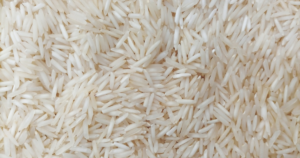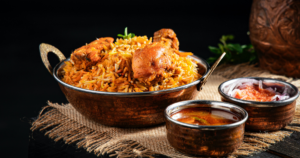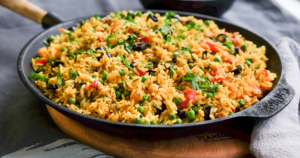
Basmati Rice Nutrition Facts 100g: A Comprehensive Guide
In this article about “Basmati Rice Nutrition Facts 100g,” you’ll discover everything you need to know about the nutritional content of this aromatic rice variety. Get ready to explore its health benefits, cooking tips, and more.
Introduction
Welcome to the world of Basmati rice, where aroma and nutrition combine to create a delightful culinary experience. In this article, we’ll delve into the nutrition facts of Basmati rice, specifically focusing on a 100g serving. From calories to vitamins, we’ll cover it all. So, let’s explore the health benefits and culinary magic of Basmati rice!
The Basics: What is Basmati Rice?

Basmati rice is a fragrant, long-grain rice variety primarily grown in the Indian subcontinent. It’s known for its delightful aroma, slender grains, and distinct nutty flavor. But what makes it even more appealing is its impressive nutritional profile.
100g Basmati Rice Nutritional Breakdown
1. Calories and Macronutrients
When it comes to Basmati rice nutrition, it’s essential to start with calories and macronutrients.
- Calories: A 100g serving of cooked Basmati rice contains approximately 121 calories, making it an excellent choice for those watching their calorie intake.
- Carbohydrates: Basmati rice is primarily a carbohydrate source, with around 25 grams of carbs per 100g. It’s an energy powerhouse.
- Protein: While it’s not a significant protein source, Basmati rice provides about 2.7 grams of protein in a 100g serving.
- Fat: Basmati rice is naturally low in fat, with less than 0.5 grams of fat per 100g.
2. Essential Vitamins and Minerals
Basmati rice also offers some essential vitamins and minerals that contribute to your overall well-being.
- Vitamin B1 (Thiamine): Basmati rice contains vitamin B1, crucial for converting food into energy.
- Niacin (Vitamin B3): This rice variety provides your body with niacin, which supports digestion and a healthy nervous system.
- Folate (Vitamin B9): Folate is essential for cell division and is found in Basmati rice.
- Manganese: Basmati rice contains manganese, an essential mineral involved in bone formation and metabolism.
3. Dietary Fiber
One of the lesser-known aspects of Basmati rice nutrition is its dietary fiber content. A 100g serving contains approximately 1.3 grams of fiber, aiding digestion and promoting a feeling of fullness.
Cooking Tips for Basmati Rice

As we have explored the “Basmati Rice Nutrition Facts”, let us find cooking tips for Basmati rice. Cooking Basmati rice to perfection is an art, and there are several key steps to follow. Here are some additional tips to ensure your rice turns out fluffy and aromatic:
- Spices and Aromatics: To enhance the flavor of Basmati rice, consider adding whole spices like cinnamon sticks, cardamom pods, or cloves to the cooking water. This infuses a subtle but delightful aroma into the rice.
- Buttering the Rice: After cooking, consider gently mixing a small amount of melted butter or ghee into the rice for added richness and flavor.
- Variety of Dishes: Basmati rice is incredibly versatile and pairs well with a wide range of dishes. Whether you’re making a biryani, pilaf, or a simple side dish, Basmati rice complements them all.
- Culinary Experience: Cooking Basmati rice is not just about preparing a meal; it’s about creating a culinary experience. Take your time, and enjoy the process of cooking this exquisite rice.
Health Benefits of Basmati Rice
Expanding on the health benefits of Basmati rice nutrition :
- Low Glycemic Index: Basmati rice has a lower glycemic index compared to other rice varieties. This means it has a slower impact on blood sugar levels, making it a preferred choice for people with diabetes.
- Weight Management: Its lower calorie and fat content makes Basmati rice a smart choice for those looking to manage their weight.
- Energy Source: The high carbohydrate content in Basmati rice makes it an efficient source of energy. Athletes and individuals with high energy expenditure can benefit from incorporating Basmati rice into their diets.
- Digestive Health: The dietary fiber in Basmati rice promotes healthy digestion by preventing constipation and supporting regular bowel movements.
- Gluten-Free: Being naturally gluten-free, Basmati rice is a safe option for individuals with gluten sensitivities and those with celiac disease.
- Low Cholesterol: Since Basmati rice is low in fat and doesn’t contain cholesterol, it can be part of a heart-healthy diet.
- Versatility: Basmati rice’s delicate flavor and long grains make it a versatile ingredient in the kitchen. It pairs well with a wide range of dishes, from savory to sweet.
Culinary Adventures with Basmati Rice
Now that we’ve explored the Basmati rice nutrition facts, let’s take a culinary journey with this exquisite grain. Basmati rice’s versatility makes it a favorite in various cuisines. Here are some exciting dishes you can prepare with Basmati rice:
1. Biryani: A Flavorful Delight
Biryani, a popular Indian dish, is a fragrant and spicy rice dish made with Basmati rice, aromatic spices, and a variety of proteins, such as chicken, lamb, or vegetables. It’s a dish that truly showcases the rich flavor of Basmati rice. The long, separate grains of Basmati rice absorbs the flavors of the spices and proteins, creating a mouthwatering combination that’s hard to resist. Biryani variations abound, from the vibrant Hyderabadi biryani to the aromatic Lucknowi biryani, offering a delightful gastronomic journey for rice lovers.
2. Vegetable Pulao: A Healthy Option

Vegetable pulao is a simple yet nutritious dish made with Basmati rice and a medley of fresh vegetables. It’s a great way to enjoy the delicate Basmati rice flavor while getting a dose of vitamins and minerals from the vegetables. You can customize your vegetable pulao with your favorite vegetables, such as peas, carrots, bell peppers, and beans. Aromatic spices like cumin, cardamom, and cloves infuse the rice with a delightful fragrance. Vegetable pulao is not only delicious but also a healthy option for a well-rounded meal.
3. Lemon Rice: A Tangy Twist
Lemon rice is a South Indian favorite that combines the zesty flavor of lemon with the fragrant Basmati rice. It’s a quick and easy dish that’s perfect for a light lunch or a refreshing side dish. To prepare lemon rice, cooked Basmati rice is tossed with a tempering of mustard seeds, lentils, curry leaves, and a generous squeeze of fresh lemon juice. The result is a tangy and aromatic dish that has a burst of flavor in every bite. Lemon rice is often served with a side of pickle or yogurt for a satisfying meal.
4. Rice Pudding: A Sweet Treat

Basmati rice isn’t just for savory dishes; it’s also a fantastic choice for delectable desserts. Rice pudding, also known as kheer in many Indian households, is a delightful sweet treat. Basmati rice is simmered in milk, sweetened with sugar, and flavored with cardamom, saffron, and rose water. The long grains of Basmati rice absorb the creamy, aromatic milk, creating a dessert that’s a feast for the senses. Rice pudding can be garnished with nuts and raisins for added texture and flavor. It’s the perfect conclusion to a hearty meal.
5. Rice Pilaf: An International Delicacy
Basmati rice’s versatility extends beyond traditional Indian dishes. It’s a star ingredient in international cuisines, too. In Middle Eastern cuisine, Basmati rice is used to prepare fragrant pilaf dishes. Rice pilaf involves sautéing the rice in butter or oil and then simmering it with a flavorful broth, along with ingredients like spices, vegetables, and proteins. The result is a fluffy, aromatic rice dish that complements dishes like kebabs and stews.
6. Sushi: Japanese Delicacy with a Twist

Sushi, a beloved Japanese dish, typically features short-grain rice seasoned with rice vinegar and sugar. However, Basmati rice can be used to create a unique and fragrant twist on this classic. Sushi made with Basmati rice offers a different texture and flavor, making it a delightful fusion of Japanese and Indian culinary traditions.
These are just a few examples of the delightful culinary adventures you can embark on with Basmati rice. Whether you’re savoring the vibrant spices of biryani, enjoying the tangy notes of lemon rice, or relishing the creamy sweetness of rice pudding, Basmati rice has a place in kitchens around the world. Its versatility, flavor, and texture make it an ingredient that can be enjoyed in a wide range of dishes, both savory and sweet.
Additional Uses of Basmati Rice
Beyond the Basmati rice nutrition facts, Basmati rice has several unique uses:
- Rice Water: The starchy water left over after rinsing Basmati rice, known as “rice water,” has been used for centuries in skincare routines. It’s believed to have a soothing effect on the skin.
- Fragrance: Basmati rice isn’t just appreciated for its taste but also for its aroma. In some cultures, it’s used to create scented sachets or potpourri.
- Culinary Fusion: Chefs worldwide have embraced Basmati rice in fusion cuisine, incorporating it into a variety of dishes to create innovative and delicious meals.
FAQs related to Basmati Rice Nutrition Facts 100g
Q: Is Basmati rice better than regular rice for health?
A: Basmati rice is a healthier option due to its lower glycemic index and aromatic flavor.
Q: Can I use Basmati rice for risotto?
A: While Arborio rice is traditional for risotto, you can use Basmati rice for a unique twist.
Q: How can I store Basmati rice to maintain its freshness?
A: Store it in an airtight container in a cool, dry place to preserve its aroma and flavor.
Q: Is Basmati rice suitable for a keto diet?
A: Basmati rice is not keto-friendly due to its carbohydrate content.
Q: Can I use Basmati rice for sushi?
A: While short-grain rice is preferred for sushi, Basmati rice can be used as an alternative.
Q: Is Basmati rice good for a vegan diet?
A: Yes, it’s vegan-friendly and complements a variety of plant-based dishes.
Q: Can Basmati rice be used in desserts?
A: Absolutely! Basmati rice can be used to make delectable rice puddings and sweet rice-based desserts.
Q: What is the origin of Basmati rice?
A: Basmati rice is primarily grown in the Indian subcontinent, with India and Pakistan being the main producers.
Conclusion
In this extended guide on Basmati Rice Nutrition Facts 100g, we’ve explored the nutritional content, cooking tips, health benefits, additional uses, and some common questions about this remarkable rice variety. Whether you’re a culinary enthusiast or someone seeking a healthy dietary choice, Basmati rice offers both taste and nourishment. Embrace the aromatic delight it brings to your table and savor its numerous advantages.




